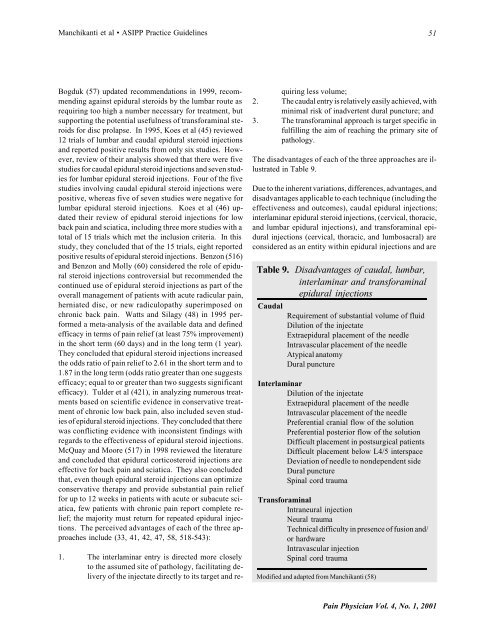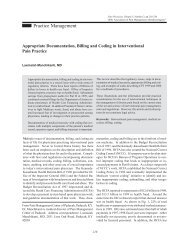ASIPP Practice Guidelines - Pain Physician
ASIPP Practice Guidelines - Pain Physician
ASIPP Practice Guidelines - Pain Physician
You also want an ePaper? Increase the reach of your titles
YUMPU automatically turns print PDFs into web optimized ePapers that Google loves.
Manchikanti et al • <strong>ASIPP</strong> <strong>Practice</strong> <strong>Guidelines</strong><br />
51<br />
Bogduk (57) updated recommendations in 1999, recommending<br />
against epidural steroids by the lumbar route as<br />
requiring too high a number necessary for treatment, but<br />
supporting the potential usefulness of transforaminal steroids<br />
for disc prolapse. In 1995, Koes et al (45) reviewed<br />
12 trials of lumbar and caudal epidural steroid injections<br />
and reported positive results from only six studies. However,<br />
review of their analysis showed that there were five<br />
studies for caudal epidural steroid injections and seven studies<br />
for lumbar epidural steroid injections. Four of the five<br />
studies involving caudal epidural steroid injections were<br />
positive, whereas five of seven studies were negative for<br />
lumbar epidural steroid injections. Koes et al (46) updated<br />
their review of epidural steroid injections for low<br />
back pain and sciatica, including three more studies with a<br />
total of 15 trials which met the inclusion criteria. In this<br />
study, they concluded that of the 15 trials, eight reported<br />
positive results of epidural steroid injections. Benzon (516)<br />
and Benzon and Molly (60) considered the role of epidural<br />
steroid injections controversial but recommended the<br />
continued use of epidural steroid injections as part of the<br />
overall management of patients with acute radicular pain,<br />
herniated disc, or new radiculopathy superimposed on<br />
chronic back pain. Watts and Silagy (48) in 1995 performed<br />
a meta-analysis of the available data and defined<br />
efficacy in terms of pain relief (at least 75% improvement)<br />
in the short term (60 days) and in the long term (1 year).<br />
They concluded that epidural steroid injections increased<br />
the odds ratio of pain relief to 2.61 in the short term and to<br />
1.87 in the long term (odds ratio greater than one suggests<br />
efficacy; equal to or greater than two suggests significant<br />
efficacy). Tulder et al (421), in analyzing numerous treatments<br />
based on scientific evidence in conservative treatment<br />
of chronic low back pain, also included seven studies<br />
of epidural steroid injections. They concluded that there<br />
was conflicting evidence with inconsistent findings with<br />
regards to the effectiveness of epidural steroid injections.<br />
McQuay and Moore (517) in 1998 reviewed the literature<br />
and concluded that epidural corticosteroid injections are<br />
effective for back pain and sciatica. They also concluded<br />
that, even though epidural steroid injections can optimize<br />
conservative therapy and provide substantial pain relief<br />
for up to 12 weeks in patients with acute or subacute sciatica,<br />
few patients with chronic pain report complete relief;<br />
the majority must return for repeated epidural injections.<br />
The perceived advantages of each of the three approaches<br />
include (33, 41, 42, 47, 58, 518-543):<br />
1. The interlaminar entry is directed more closely<br />
to the assumed site of pathology, facilitating delivery<br />
of the injectate directly to its target and requiring<br />
less volume;<br />
2. The caudal entry is relatively easily achieved, with<br />
minimal risk of inadvertent dural puncture; and<br />
3. The transforaminal approach is target specific in<br />
fulfilling the aim of reaching the primary site of<br />
pathology.<br />
The disadvantages of each of the three approaches are illustrated<br />
in Table 9.<br />
Due to the inherent variations, differences, advantages, and<br />
disadvantages applicable to each technique (including the<br />
effectiveness and outcomes), caudal epidural injections;<br />
interlaminar epidural steroid injections, (cervical, thoracic,<br />
and lumbar epidural injections), and transforaminal epidural<br />
injections (cervical, thoracic, and lumbosacral) are<br />
considered as an entity within epidural injections and are<br />
Table 9. Disadvantages of caudal, lumbar,<br />
interlaminar and transforaminal<br />
epidural injections<br />
Caudal<br />
Requirement of substantial volume of fluid<br />
Dilution of the injectate<br />
Extraepidural placement of the needle<br />
Intravascular placement of the needle<br />
Atypical anatomy<br />
Dural puncture<br />
Interlaminar<br />
Dilution of the injectate<br />
Extraepidural placement of the needle<br />
Intravascular placement of the needle<br />
Preferential cranial flow of the solution<br />
Preferential posterior flow of the solution<br />
Difficult placement in postsurgical patients<br />
Difficult placement below L4/5 interspace<br />
Deviation of needle to nondependent side<br />
Dural puncture<br />
Spinal cord trauma<br />
Transforaminal<br />
Intraneural injection<br />
Neural trauma<br />
Technical difficulty in presence of fusion and/<br />
or hardware<br />
Intravascular injection<br />
Spinal cord trauma<br />
Modified and adapted from Manchikanti (58)<br />
<strong>Pain</strong> <strong>Physician</strong> Vol. 4, No. 1, 2001
















